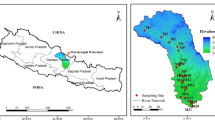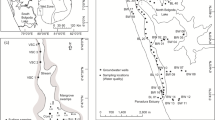Abstract
The water quality in Poyang Lake has changed in recent 20 years according to the long-term data analysis. The main driving factors of water quality evolution trends are the increasing pollutant loads and hydrological regime alterations. The water levels in the lake have declined, which led to the shortening of the limnetic faces period of the lake. The seasonal allocations of basin inflow and lake outflow have also been altered mildly by some hydraulic facilities in the basin. To study the impacts of changing hydrological regime on water quality, a two-dimensional depth-averaged model for hydrodynamics and water quality is set up, validated, and applied to simulate two hydrological processes before and after Three Gorges Reservoir as 1956–2002 and 2003–2015 scenarios. The results reveal that water quality in lake are mainly determined by the pollutant loads and are influenced by the hydrological regime particularly in spring and autumn. The hydrological regime changes of Poyang Lake have resulted in 10.6 and 11.7% increases in TN concentrations associate with 12.4 and 13.6% increases in TP concentrations during the periods of April–May and September–October.















Similar content being viewed by others
References
Castro MJ, Ferreiro AM, Garcfa-Rodriguez JA et al (2005) The numerical treatment of wet/dry fronts in shallow flows: application to one-layer and two-layer systems. Math Comput Model 42:419–439
Chen W (2010) Water environment loads capacity analysis and water environment management in Poyang Lake. Dissertation, Nanchang University (in Chinese)
Dai ZJ, Du JZ, Li JF et al (2008) Runoff characteristics of the Chang River during 2006: effect of extreme drought and the impounding of the Three Gorges Dam. Geophys Res Lett 35(7):L07406
Ding JH, Huang GX, Xu XF et al (2012) Research on the runoff, sediment and water quality change of the Poyang Lake basin under the impact of human activities and natural change. Jiangxi Hydraul Sci Techol 38(4):224–230 (in Chinese)
Du YL, Pan SQ, Chen YP (2010) Modelling the effect of wave overtopping on nearshore hydrodynamics and morphodynamics around shore-parallel breakwaters. Coast Eng 57:812–826
Du YL, Zhou HD, Liu XB (2011) Modeling the impacts of the hydraulic infrastructure in Poyang Lake on hydrodynamics and water quality. J China Inst Water Resour Hydropower Res 9(4):249–256 (in Chinese)
Fang C, Cao W, Mao J et al (2012) Relationship between Poyang Lake and Yangtze River and influence of Three Georges Reservoir. J Hydraul Eng 43(2):175–181 (in Chinese)
Feng L, Hu CM, Chen XL, Li RF (2011) Satellite observations make it possible to estimate Poyang Lake’s water budget. Environ Res Lett 6(044023):7
Guo H, Qi Hu, Zhang Q, Feng S (2012) Effects of the Three Gorges Dam on Yangtze River flow and river interaction with Poyang Lake, China: 2003–2008. J Hydrol 416–417:19–27
Hu C (2010) Relationship between Poyang Lake and Yangtze River and influence of Three Georges Reservoir. Dissertation, Nanchang University (in Chinese)
Hu Q, Feng S, Guo H et al (2007) Interactions of the Yangtze river flow and hydrologic processes of the Poyang Lake, China. J Hydrol 347(1/2):90–100
Hui FM, Xu B, Huang HB et al (2008) Modeling spatial-temporal change of Poyang Lake using multitemporal land sat imagery. Int J Remote Sens 29(20):5767–5784
Jiang Z (2007) Water environmental loads capacity analysis in Poyang Lake. Dissertation, Nanchang University (in Chinese)
Lai XJ, Jiang JH, Huang Q et al (2011) Two dimensional hydrodynamics and water quality modeling. J Lake Sci 23(6):893–902 (in Chinese)
Li YY(2007) Study on water quality evaluation and prediction of the section from Xingzi to Hamashi in Poyang Lake. Dissertation, Nanchang University (in Chinese)
Liu J, Zhang Q, Xu CY et al (2009) Characteristics of runoff variation of Poyang Lake watershed in the past 50 years. Trop Geogr 29(3):213–218 (in Chinese)
Luo W, Zhang X, Deng ZM et al (2013) Variation of the total runoff into Poyang Lake and drought-flood abrupt alternation during the past 50 years. J Basic Sci Eng 21(5):845–856 (in Chinese)
Ma SL, Ni ZK, Wang SR et al (2016) Organic phosphorus forms in sediments and their relationship with the change of water level in Poyang Lake. Acta Sci Circumst 36(10):3607–3614 (in Chinese)
Mao ZP, Zhou HD, Wang SY (2011) Characteristics of water environment in Poyang Lake. J China Inst Water Resour Hydropower Res 9(4):267–273 (in Chinese)
Qing T (2011) From vulnerability to sustainability: rural development in the Poyang Lake region of China amid institutional changes and flood hazards. Dissertation, University of Michigan
Wang SR, Su JM, Ni ZK et al (2013) Investigation on pollution situation and countermeasures in Poyang Lake. J Environ Eng Technol 3(4):342–349 (in Chinese)
Wang RR, Yang GS, Wang XL et al (2014a) Progress of research on the relationship between the Yangtze River and its connected lakes in the middle reaches. J Lake Sci 26(1):1–8 (in Chinese)
Wang P, Lai GY, Huang XL (2014b) Modeling the water level changes after the construction of hydraulic gate in Poyang Lake. J Lake Sci 26(1):29–36 (in Chinese)
Wang YM, Ni ZK, Feng ML et al (2017) Characteristics of phosphorus release in sediment and its response to the change of water level in Poyang Lake in dry season. Acta Sci Circumst 37(10):3804–3812 (in Chinese)
Wu Y (2009) The distribution pattern of nutrient and dynamic analysis of eutrophication in Poyang Lake region. Master thesis, Central South University of Forestry and Technology
Xie HL, Wang P, Huang HS (2013) Ecological risk assessment of land use change in the Poyang Lake Eco-economic Zone, China. Int J Environ Res Publ Health 10(1):328–346
Ye XC, Zhang Q, Liu J et al (2013) Distinguishing the relative impacts of climate change and human activities on variation of streamflow in the Poyang Lake catchment, China. J Hydrol 494:83–95
Zhao JK (2011) Study on the rules of river-lake water exchange in mid-lower reaches of Yangtze River. Dissertation, East China Normal University (in Chinese)
Acknowledgements
This study was supported by the National Natural Science Foundation of China (51279215 and 51439007). Thanks also go to all project partners as Hydrology Bureau of Jiangxi Province (HBJXP), Chinese Research Academy of Environmental Sciences (CRAES) for their support and providing data. The authors are grateful for the valuable comments and suggestions from reviewers.
Author information
Authors and Affiliations
Corresponding author
Rights and permissions
About this article
Cite this article
Du, Y., Peng, W., Wang, S. et al. Modeling of water quality evolution and response with the hydrological regime changes in Poyang Lake. Environ Earth Sci 77, 265 (2018). https://doi.org/10.1007/s12665-018-7408-4
Received:
Accepted:
Published:
DOI: https://doi.org/10.1007/s12665-018-7408-4




